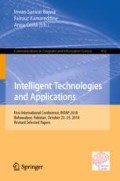Abstract
Gait impairments are the prerequisite for the diagnosis of Parkinson’s disease (PD). The sole purpose of this study is to objectively and automatically classify between healthy subjects and Parkinson patients. In this research total, 16 different positioned force sensors were attached to the shoes of subjects that recorded the Multisignal Vertical Ground Reaction Force (VGRF). From all sensors signals using 1024 window size over the raw signals, using the Packet wavelet transform (PWT) five different features namely entropy, energy, variance, standard deviation and waveform length were extracted and support vector machine (SVM) is applied to distinguish between Parkinson patients and healthy subjects. SVM is trained on 85% of the dataset and validated on 15% dataset. The training cohort depends on 93 patients with idiopathic PD (mean age: 66.3 years; 63% men and 37% women), and 73 healthy controls (mean age: 66.3 years; 55% men and 45% women). Among 16 sensors, 8 force sensors were attached to the left foot of subject and the remaining 8 on the right foot. The results show that 5th sensor worn on a Medial aspect of the dorsum of right foot represented by R5 gives 90.3% accuracy. Hence this research gives the insight to use only single wearable force sensor. Therefore, this study concludes that a single sensor may serve for identification between Parkinson patient and healthy subject.
Access this chapter
Tax calculation will be finalised at checkout
Purchases are for personal use only
References
Hariharan, M., Polat, K., Sindhu, R.: A new hybrid intelligent system for accurate detection of Parkinson’s disease. Comput. Methods Programs Biomed. 113, 904–913 (2014)
Plotnik, M., Giladi, N., Balash, Y., Peretz, C., Hausdorff, J.M.: Is freezing of gait in Parkinson’s disease related to asymmetric motor function? Ann. Neurol. 57, 656–663 (2005)
Tao, W., Liu, T., Zheng, R., Feng, H.: Gait analysis using wearable sensors. Sensors 12, 2255–2283 (2012)
Godfrey, A.: Wearables for independent living in older adults: gait and falls. Maturitas 100, 16–26 (2017)
Haller, S., Badoud, S., Nguyen, D., Garibotto, V., Lovblad, K., Burkhard, P.: Individual detection of patients with Parkinson disease using support vector machine analysis of diffusion tensor imaging data: initial results. Am. J. Neuroradiol. 33, 2123–2128 (2012)
Das, S., et al.: Quantitative measurement of motor symptoms in Parkinson’s disease: a study with full-body motion capture data. In: 2011 Annual International Conference of the IEEE on Engineering in Medicine and Biology Society (EMBC), pp. 6789–6792 (2011)
Eskofier, B.M., et al.: An overview of smart shoes in the internet of health things: gait and mobility assessment in health promotion and disease monitoring. Appl. Sci. 7, 986 (2017)
Soubra, R., Diab, M.O., Moslem, B.: Identification of Parkinson’s disease by using multichannel vertical ground reaction force signals. In: 2016 International Conference on Bio-engineering for Smart Technologies (BioSMART), pp. 1–4 (2016)
Perumal, S.V., Sankar, R.: Gait monitoring system for patients with Parkinson’s disease using wearable sensors. In: 2016 IEEE on Healthcare Innovation Point-of-Care Technologies Conference (HI-POCT), pp. 21–24 (2016)
Camps, J., et al.: Deep learning for detecting freezing of gait episodes in Parkinson’s disease based on accelerometers. In: Rojas, I., Joya, G., Catala, A. (eds.) IWANN 2017. LNCS, vol. 10306, pp. 344–355. Springer, Cham (2017). https://doi.org/10.1007/978-3-319-59147-6_30
Tahafchi, P., et al.: Freezing-of-gait detection using temporal, spatial, and physiological features with a support-vector-machine classifier. In: 2017 39th Annual International Conference of the IEEE Engineering in Medicine and Biology Society (EMBC), pp. 2867–2870 (2017)
Tahir, N.M., Manap, H.H.: Parkinson disease gait classification based on machine learning approach. J. Appl. Sci. 12, 180–185 (2012)
Manap, H.H., Tahir, N.M., Yassin, A.I.M.: Statistical analysis of parkinson disease gait classification using artificial neural network. In: 2011 IEEE International Symposium on Signal Processing and Information Technology (ISSPIT), pp. 060–065 (2011)
Gabel, M., Gilad-Bachrach, R., Renshaw, R., Schuster, A.: Full body gait analysis with Kinect. In: 2012 Annual International Conference of the IEEE on Engineering in Medicine and Biology Society (EMBC), pp. 1964–1967 (2012)
Goldberger, A.L., et al.: PhysioBank, PhysioToolkit, and PhysioNet. Circulation 101, e215–e220 (2000)
van der Hoorn, A., Bartels, A.L., Leenders, K.L., de Jong, B.M.: Handedness and dominant side of symptoms in Parkinson’s disease. Parkinsonism Relat. Disord. 17, 58–60 (2011)
Infotronic.nl - infotronic Resources and Information. http://www.infotronic.nl/#CDG
Rong, Y., Hao, D., Han, X., Zhang, Y., Zhang, J., Zeng, Y.: Classification of surface EMGs using wavelet packet energy analysis and a genetic algorithm-based support vector machine. Neurophysiology 45, 39–48 (2013)
Polikar, R.: The wavelet tutorial (1996)
Wavelet Packets Transform-Mathswork. https://www.mathworks.com/help/wavelet/ug/wavelet-packets.html. Accessed 24 Jan 2018
Support Vector Machine for Binary Classification. http://www.mathworks.com/help/stats/support-vector-machines-for-binaryclassification.html. Accessed 24 Jan 2018
Train Classification Models in Classification Learner App. https://www.mathworks.com/help/stats/train-classification-models-in-classification-learner-app.html. Accessed 24 Jan 2018
Acknowledgements
This research was supported by Selçuk University, Konya–42002, Turkey and Mehran University of Engineering and Technology, Jamshoro–76062, Pakistan. We thank our colleagues from both institutes who provided undiminished logical acumen that greatly supported the research. We pay special thanks to Assistant Prof. Zaigham Abbass Shah and Mr. Shakir Shakoor Khatti for their guidance and unbroken interest in this research work.
Author information
Authors and Affiliations
Corresponding author
Editor information
Editors and Affiliations
Rights and permissions
Copyright information
© 2019 Springer Nature Singapore Pte Ltd.
About this paper
Cite this paper
Channa, A., Ceylan, R., Baqai, A. (2019). Machine Learning for Analyzing Gait in Parkinson’s Patients Using Wearable Force Sensors. In: Bajwa, I., Kamareddine, F., Costa, A. (eds) Intelligent Technologies and Applications. INTAP 2018. Communications in Computer and Information Science, vol 932. Springer, Singapore. https://doi.org/10.1007/978-981-13-6052-7_47
Download citation
DOI: https://doi.org/10.1007/978-981-13-6052-7_47
Published:
Publisher Name: Springer, Singapore
Print ISBN: 978-981-13-6051-0
Online ISBN: 978-981-13-6052-7
eBook Packages: Computer ScienceComputer Science (R0)

